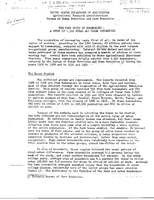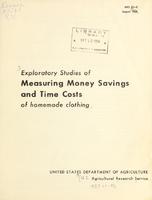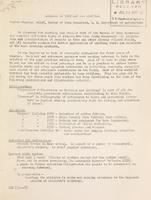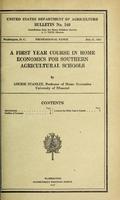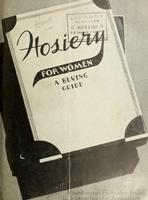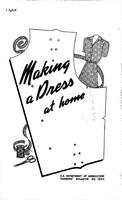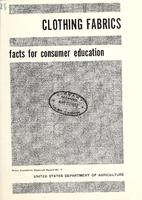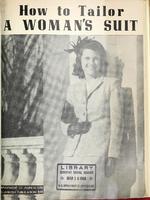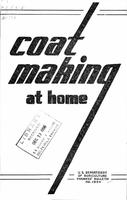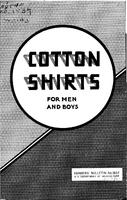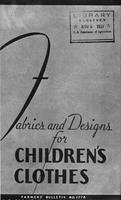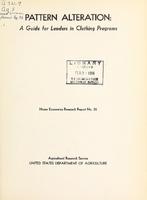Browse Items: 181
The Time Costs of Homemaking: A Study of 1,500 Rural and Urban Households
The occupation of homemaking ranks first of all, in terms of the number of workers. According to the 1940 Census, 29 million persons were engaged in homemaking, compared with only 10 million in the next largest occupational group, manufacturing. Interest in the amount and kind of tasks performed by these workers has prompted a number of studies of…
Research on Time Spent in Homemaking: An Annotated List of References
This list of references includes studies of time spent in homemaking in the United States. It includes only research published since 1945, with one exception. This earlier study (listed as the first item because it preceded the others in time) is included because it is still widely referred to, and has been used both as a pattern and as a base of…
Exploratory Studies of Measuring Money Savings and Time Costs of Homemade Clothing
This report presents some of the problems encountered in recent research concerned with one aspect of home production- -the economy of home sewing. A summary of the findings on the time and money costs of making garments at home is included. Information on these costs was reported in somewhat more detail in Rural Family Living, April 1956 and…
Research in Textiles and Clothing
In planning the clothing and textile work of the Bureau of Home Economics two somewhat different types of studies have been found necessary: (1) compilation and interpretation of results in this and other closely related fields, and (2) research studies for better application of existing facts and solutions of the more pressing problems.
In the…
In the…
Home Canning of Fruits, Vegetables, and Meats
CANNING is a method of using heat and airtight containers to preserve food as nearly as possible in the condition in which it is served when freshly cooked. It is a desirable and economical method of preserving many foods so that their use can be distributed over seasons and to places where they are not available fresh. Canned foods thus make…
Canning Fruits and Vegetables at Home
This bulletin attempts to give in as simple form as possible the application of scientific principles to home canning of fruits and vegetables. Methods of canning are based on knowledge of the causes of food spoilage and ways of preventing it. Scientific research is constantly throwing new light on this subject, and the methods recommended in this…
Ice Creams Frozen Without Stirring
SATISFACTORY desserts may be frozen without stirring by packing in ice and salt or by placing in the trays of the mechanical refrigerator. A fairly rich mixture must, be used in these desserts and the ingredients carefully combined in order to obtain a satisfactory texture. Such ice creams are neverso smooth as those prepared in a freezer with a…
A First-Year Course in Home Economics for Southern Agricultural Schools
This bulletin outlines a course of study in home economics for southern high schools. It emphasizes the connection between such instruction and actual home experience and the danger arising from formal methods of presentation. It calls attention to underlying general principles and applies them in a typical course of study, which, while based on…
Hosiery For Women: A Buying Guide
TEN POINTS IN HOSIERY SELECTION
1 Fiber. — Cotton, rayon, wool, silk, or a mixture, whichever meets the wearer's needs and is most suitable for the occasion.
2 Weight. — Are the hose for hard, moderate, or light wear, or for appearance only?
3 Texture. — Are the yarns tightly twisted and the fabric closely knitted so that the hose will…
1 Fiber. — Cotton, rayon, wool, silk, or a mixture, whichever meets the wearer's needs and is most suitable for the occasion.
2 Weight. — Are the hose for hard, moderate, or light wear, or for appearance only?
3 Texture. — Are the yarns tightly twisted and the fabric closely knitted so that the hose will…
Making a Dress at Home
A needed dress . . . pride in achievement . . . something learned — these are the rewards of making a first dress. The job will not be hard if you take it step by step with care and attention to detail. Then when you have learned the principles of putting together and finishing a simple dress, you can apply them in the making of any garment.
To…
To…
Clara B. Thompson, Director of Home Economics, Farm Security Administration
View full record for details.
Secretary of Agriculture Wallace commissioning Miss Elizabeth U. Hoffman of the office of Home Economics to demonstrate the labor saving methods taught by county home demonstrating agents. C.W. Pugglsey also in photo. (Asst. to the Secy.)
Secretary of Agriculture Wallace commissioning Miss Elizabeth U. Hoffman of the office of Home Economics to demonstrate the labor saving methods taught by county home demonstrating agents. C.W. Pugglsey also in photo. (Asst. to the Secy.)
Cotton Hosiery for Women: A Portfolio of Design
At the request of the Agricultural Appropriations Committee of the House of Representatives, the Bureau of Home Economics has been designing cotton hose for women. The purpose is to develop acceptable hose that can be made from American-grown cotton.
The full-fashioned designs illustrated here were knit from
combed, gassed, and mercerized…
The full-fashioned designs illustrated here were knit from
combed, gassed, and mercerized…
Clothing Fabrics: Facts for Consumer Education
Quality in a fabric depends on many things. The kind and grade of fiber used, the processes by which the fibers were made into yarns, the construction of the material, the fastness of the dye, and the types of finishes applied all affect the quality of a fabric and the satisfaction it will give in use. Though many fabric properties can be…
How to Tailor a Woman's Suit
Well-made tailored suits of good-quality material are so expensive that many women are trying to save by making their own. It is easy to make a tailored suit if you are skillful at sewing and have the patience to do careful work. But don't attempt a suit if you are an amateur at sewing.
You can give your suit that "custom-made" look by using…
You can give your suit that "custom-made" look by using…
Coat Making at Home
A well-made, well-fitted coat is a joy to the wearer and a pride to the maker. Tailoring reaches its highest art in coat making. Many a woman is finding that she can give the tailor-made touch to a coat for herself or the children once she understands some of the tricks of the trade and takes time to do exacting work.
Coats are usually one of…
Coats are usually one of…
Cotton Shirts for Men and Boys
Both producers and consumers are interested in wise selection and effective use of American textiles. This bulletin gives the qualities to look for in buying men's and boys' shirts. They are not only an important item in a family's clothing budget but are also a garment for which cotton, the chief fiber grown in the United States, is preeminently…
Fabrics and Designs for Children's Clothes
For some years the Bureau of Home Economics has been studying fabrics and designs for children's clothing in response to two widespread demands.
Both producers and consumers are seeking new and better ways of utilizing fabrics made of cotton and wool, the textile fibers of great importance to American agriculture. Cotton is particularly well…
Both producers and consumers are seeking new and better ways of utilizing fabrics made of cotton and wool, the textile fibers of great importance to American agriculture. Cotton is particularly well…
Pattern Alteration: A Guide for Leaders in Clothing Programs
Every woman who sews for herself or her family wants to make attractive, durable, well-fitting clothes. Garments that do not fit are a waste of time and materials because they are uncomfortable, do not withstand hard wear, and give no sense of pride or well-being. The first step toward excellent fit in clothes is a pattern that fits properly. If a…
The Paper Dress Form
Frequent requests received by the Department of Agriculture for directions for making gummed paper dress forms have led to the preparation of this circular. It should be understood, however, that the making of these forms having been first taught by the extension workers in the States, the directions herein given are largely a compilation from…
 An official website of the United States government.
An official website of the United States government.


